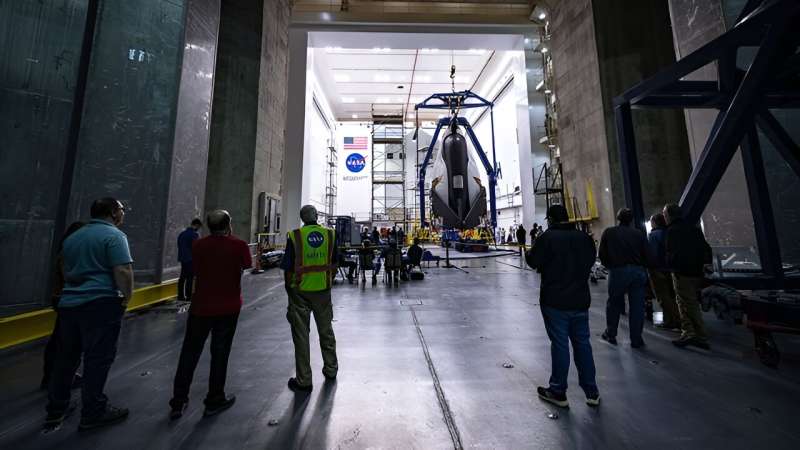This article has been reviewed according to Science X's editorial process and policies. Editors have highlighted the following attributes while ensuring the content's credibility:
fact-checked
trusted source
proofread
Dream Chaser is getting tested at NASA

After a journey spanning almost two decades, Sierra Nevada Corporation's Dream Chaser reusable spaceplane, named Tenacity, is officially undergoing environmental testing at NASA's Neil Armstrong Test Facility located at NASA's Glenn Research Center in anticipation of its maiden flight to the International Space Station (ISS), currently scheduled for April 2024.
The environmental testing consists of analyzing the spacecraft's ability to withstand rigorous vibrations during launch and re-entry, along with the harsh environment of outer space, including extreme temperature changes and vacuum conditions. This testing comes after Sierra Space announced the completion of Tenacity at its facilities in Louisville, Colorado last month, along with the delivery of Sierra Space's cargo module, Shooting Star, to the Neil Armstrong Test Facility that same month, as well.
"At Sierra Space, we are ushering in the next industrial revolution with a business and technology platform that provides our customers with a complete turn-key solution offering space as a service," Tom Vice, Sierra Space CEO, said in an official statement.
"Our platform includes Dream Chaser, a revolutionary, highly reusable commercial spaceplane with global runway access, and the first business-ready commercial space station, leveraging the most advanced expandable structural architecture that will exponentially decrease the cost of product development and manufacturing in space."
Sierra Nevada naming its first spacecraft "Tenacity" is only fitting given Dream Chaser's long and difficult journey getting to this point. This includes rejections, company buyouts, legal proceedings, engineering designs, test flights, and finally being selected by NASA in January 2016 to deliver cargo to the ISS.
Less than a year after being approved by NASA, Dream Chaser successfully performed a successful free flight test at Edwards AFB in southern California in November 2017, which was a huge milestone for the spacecraft and the advancement of the commercial space industry.
The goal of Dream Chaser is to provide a more cost-effective method for delivering cargo and supplies to the ISS, as while the spaceplane will be launched on a rocket, it will land like an airplane just like NASA's Space Shuttle used to do. This will further enable its reusability capabilities, as NASA has contracted Dream Chaser for a minimum of six cargo resupply missions to the ISS during its contract.
Dream Chaser's maiden flight next year will be a collaboration between flight and ground controllers at the Dream Chaser Mission Control Center in Louisville, Colorado, NASA's Kennedy Space Center in Florida, and NASA's Johnson Space Center in Texas. During this flight, Tenacity will conduct a myriad of in-flight tests after launch and prior to docking with the ISS. This includes performing vehicle maneuvering demonstrations within the ISS approach ellipsoid, which is a 4 x 2 x 2-kilometer (2.5 x 1.25 x 1.25-mile) invisible border encircling the ISS.
Unlike the autonomous docking system employed on SpaceX's Dragon spacecraft, Dream Chaser will be docked and undocked to the ISS using the Canadarm2, which is a 17-meter-long (56-foot-long) robotic arm built by the Canadian Space Agency and installed on the ISS in 2001. During this mission, Tenacity is slated to deliver more than 3,500 kilograms (7,800 pounds) to the ISS and stay docked with the orbiting laboratory for approximately 45 days before being undocked by Canadarm2 and returning to Earth.
Once Dream Chaser is greenlit for future flights after this first mission, it will be capable of delivering approximately 5,200 kilograms (11,500 pounds) of supplies to the ISS while staying docked for up to 75 days. Additionally, Dream Chaser will be capable of returning more than 1,600 kilograms (3,500 pounds) of experiments and cargo from the ISS to Earth, with more than 4,000 kilograms (8,700 pounds) of trash being discarded during Earth reentry using the Shooting Star cargo module.
How will Dream Chaser help improve outer space exploration in the coming years and decades? Only time will tell.
Provided by Universe Today




















